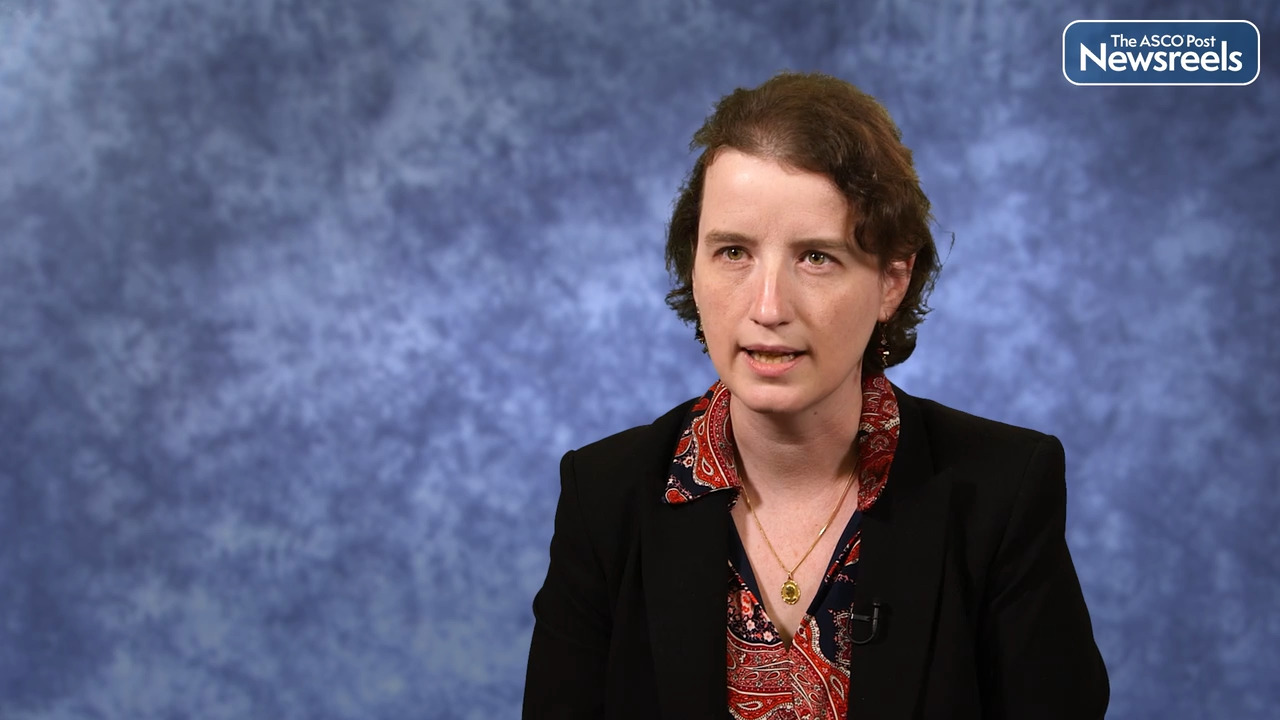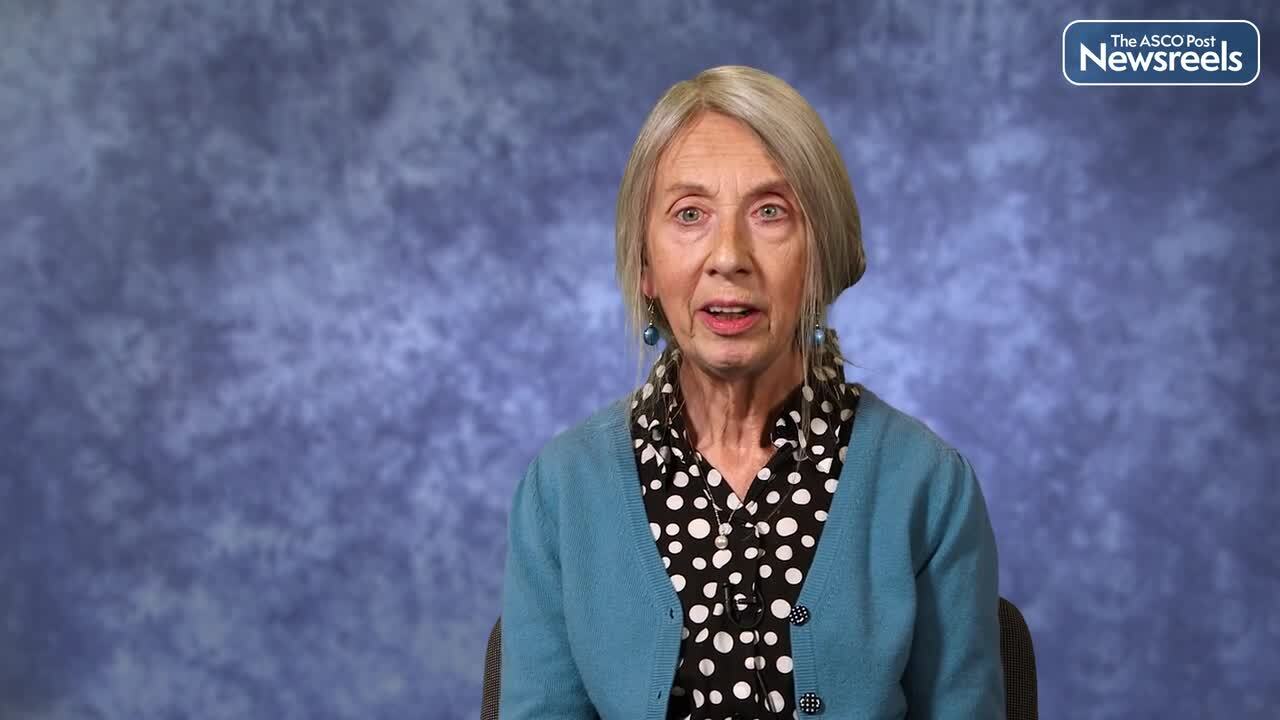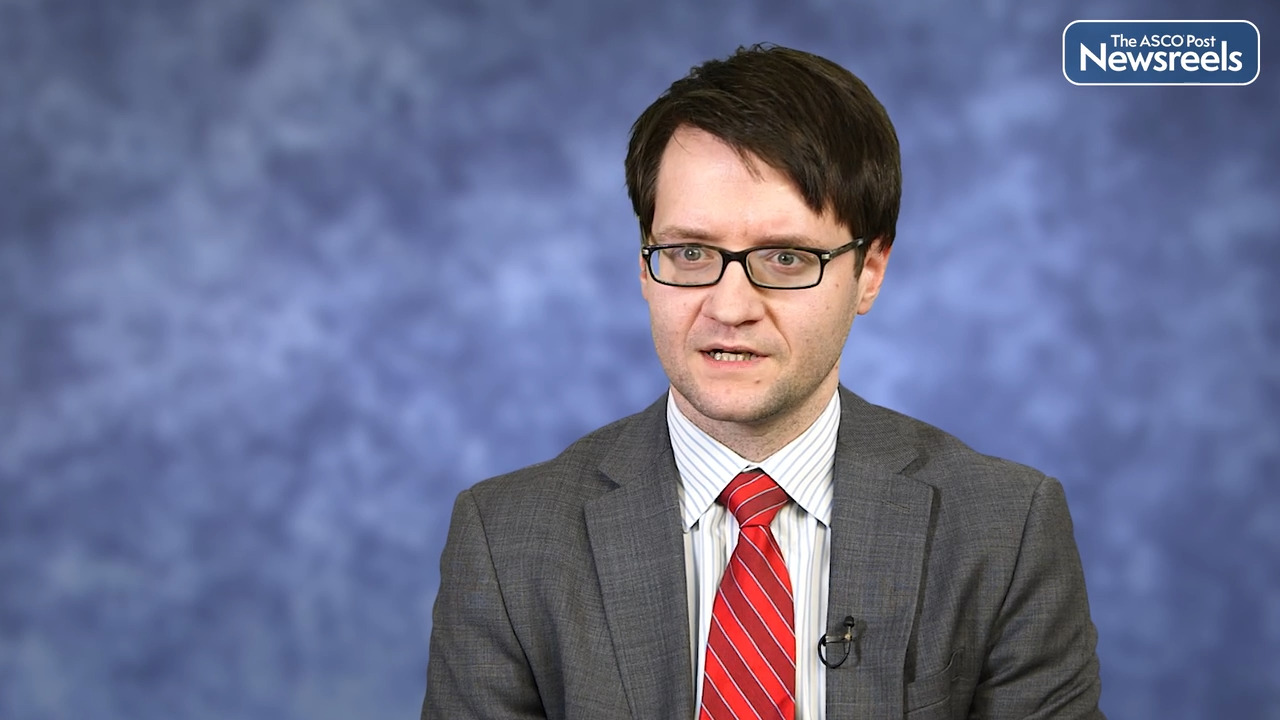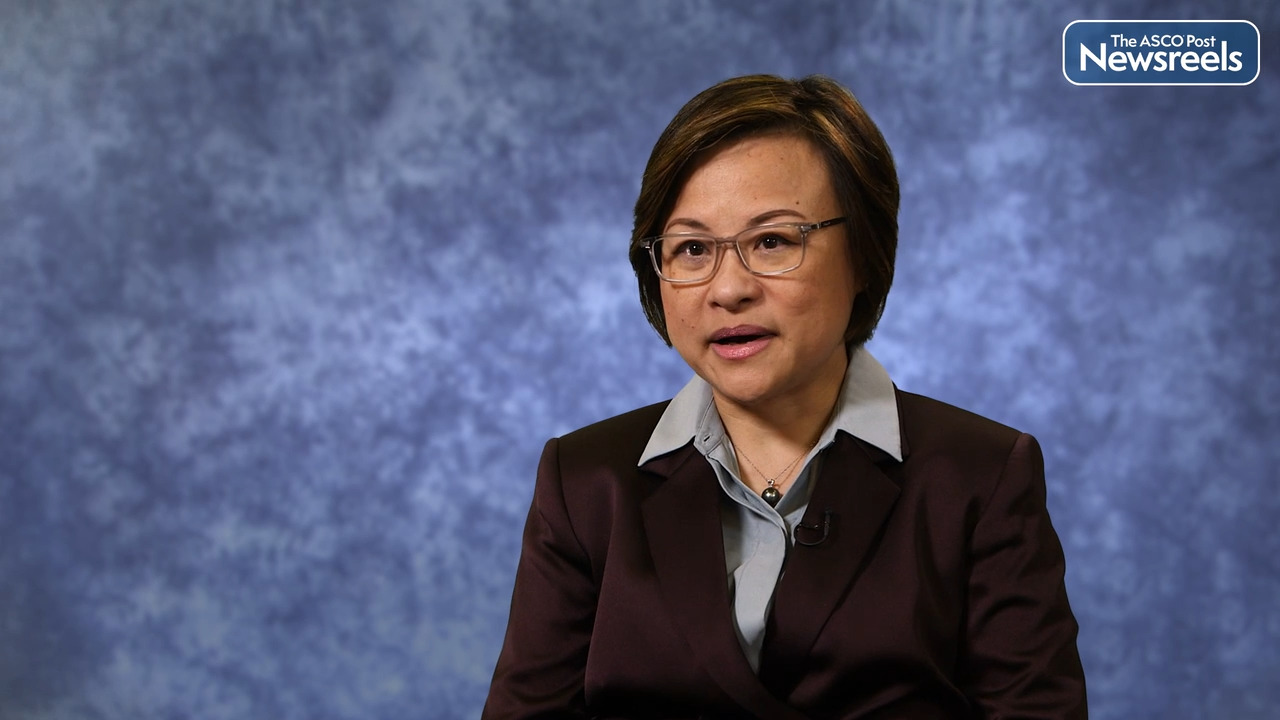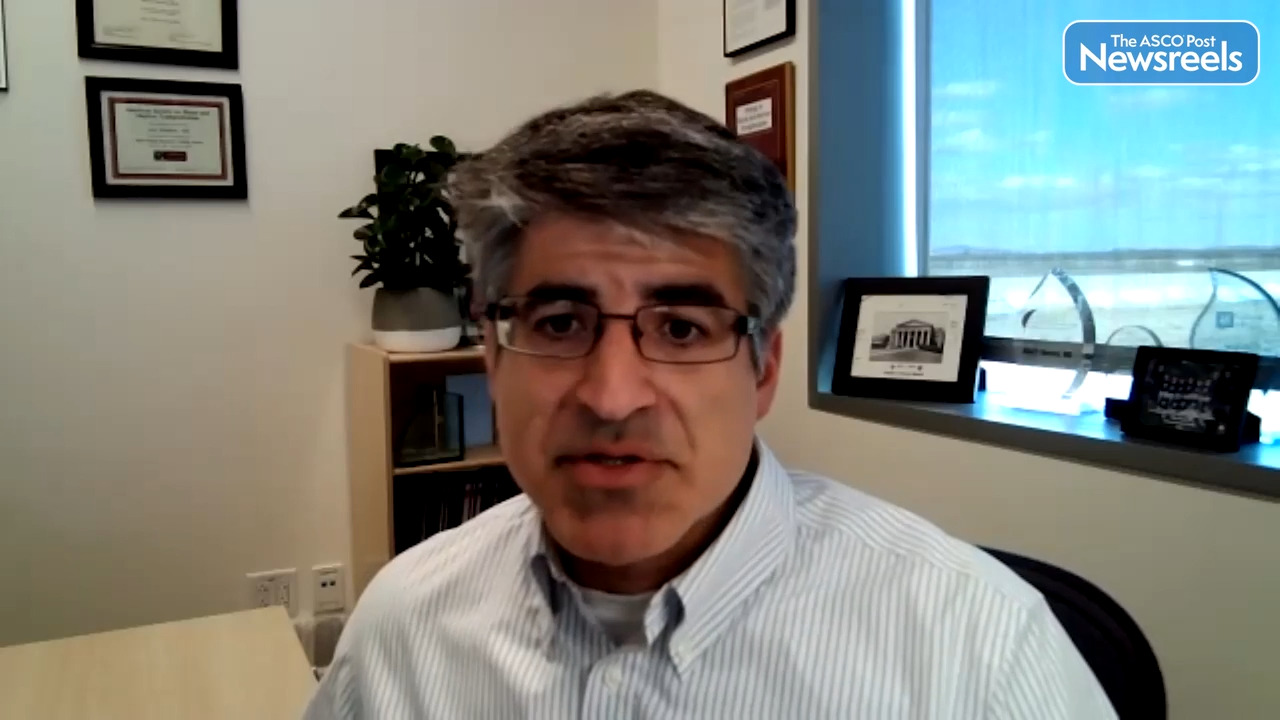Stephen M. Ansell, MD, PhD, and Patrizia Mondello, MD, PhD: New Findings on How the IRF4 Gene Shapes Tumor Immunity in Follicular Lymphoma
2022 ASH Annual Meeting and Exposition
Stephen M. Ansell, MD, PhD, and Patrizia Mondello, MD, PhD, both of the Mayo Clinic, discuss the 20% of patients with follicular lymphoma (FL) who relapse early and experience a poor prognosis. The researchers found that FLs with high levels of IRF4 expression are associated with a suppressive tumor microenvironment, and selective IRF4 silencing restores antilymphoma T-cell immunity. Further investigation is warranted to identify the mechanisms by which IRF4 controls tumor immunity to develop precision therapies for this population (Abstract 70).
Transcript
Disclaimer: This video transcript has not been proofread or edited and may contain errors.
Stephen M.Ansell:
Dr. Mondella, that was a great abstract, really appreciated what you had to say about IRF4 in follicular lymphoma. I was really interested and curious: why did you pick IRF4? What do we know about it, and why would that be important in follicular lymphoma?
Patrizia Mondella:
That is a fantastic question. The point here is we perform a [inaudible 00:00:27] studies that identify the A cluster with particular relevance of R four and poor prognosis and two microenvironment. The problem is there is not so much known about R four as interact with the tumor micro environment and we wanted to understand how it's possible that the B cells may reprogram the tumor micro environment. So for this reason, we assessed whether the R Four expression could be associated with the batter or a worse tumor micro environment. And we further dissect with the different bioinformatics analysis to evaluate first of all, which are the mono population more frequently associated with R four high or low expression. And we indeed define how I R four expression was associated with higher deregulatory cells, higher CD 40 cells and we also further identify the immuno phenotype that was exhausted and we then try to do some in vitro experiment and identify that if we have or we don't have R four, we can modulate costimulatory receptor of the B cells that then can be one of the counterpart that can influence the tumor microenvironment. But also the cytokines that are released from cells, they may or may not expressor report they can further influence the tumor microenvironment.
Stephen M.Ansell:
And you showed some really interesting information about certain receptor ligand pairs that change and that go up and down based on IRF4. Tell me a little bit more about exactly what you showed.
Patrizia Mondella:
Yeah, see what I was referring about costimulatory receptors is more fertilizer to the CD 40 expression that engage the IRF4 haler cells and the PDL one expression. So while left CD 40 was down regulated in R four high, the PDL one was up regulated and PDL one is more inhibitory. So we identify how R four is controlling the expression of this receptors and the indeed that can influence the tumor macro environment.
Stephen M.Ansell:
And this actually impacts not all of follicular lymphoma but a subset. So about how many, what percentage of follicular lymphoma is this a relevant mechanism?
Patrizia Mondella:
So as now we have identified something about a 20 or something more percent of the tumor analyze the problem is that we need to further expand our investigation in order to make a better statement. And the more interesting finding is that what we have identified at the bioinformatics level was also translated in [inaudible 00:03:16] chemistry level. And this isn't interesting because our IRF4 is currently not assessed in the normal panel that is used for follicular lymphoma. And we believe this should be actually add in order to evaluate the prognosis of the patients. But again, we have fundings that were done in a small subset and currently as you know, we are going to expand further these identification in order to make a better statement.
Stephen M.Ansell:
And clearly this is an important finding because it's an opportunity to modulate something, to change something that could in a bad prognosis group result in a better outcome. So how do you think we might be able to target, are we going to go after IRF4?, are we going to go off to CD 40? Or We going to go off to PD-l? What do you think?
Patrizia Mondella:
This is an excellent question. So first of all, one of the most important part is that IRF4 is not only expressing focal lymphoma, but we have to remember that is expressed in many other [inaudible 00:04:14] lymphoma. We need to think about that IR F4 is a prognostic also in aggressive B-cell lymphoma. I believe that there is a room for target therapy against IRF4 and we really need to better understand how to target IRF4 since it's a transcription factor. So probably a product drug might be the way to go. But it's also interesting because our four reactive antigen presentation, so it might be using combination with other immunotherapy components or can be also used to in combination with CART-cell therapy. So probably this is an exciting field that should be further expanded.
Stephen M.Ansell:
Yeah, really exciting field. So thank you. That's exceedingly interesting and again, I look forward to where this goes with the next iteration and maybe targeted therapies in the future.
Patrizia Mondella:
Thanks so much.
Stephen M.Ansell:
Thank you.
The ASCO Post Staff
Eileen M. Boyle, MD, PhD, of the Perlmutter Cancer Center, NYU Langone Health, discusses Fc-mediated antibody effector function, inflammation resolution, and oligoclonality and their role in predicting sustained measurable residual disease negativity in patients with newly diagnosed multiple myeloma who were treated with immunotherapy regimens. For the first time, an analysis of T-cell receptors shows that oligoclonal profiles seen on treatment may influence the fitness of the immune response (Abstract 100).
The ASCO Post Staff
Irene Roberts, MD, of Oxford’s Weatherall Institute of Molecular Medicine, discusses children with Down syndrome, who have a more than 100-fold increased risk of developing acute myeloid leukemia before their fourth birthday compared to children without Down syndrome. Their risk of acute lymphoblastic leukemia is also increased by around 30-fold. Dr. Roberts details current knowledge about the biologic and molecular basis of this relationship between leukemia and Down syndrome, the role of trisomy 21 in leukemogenesis, and the clinical implications of these findings.
The ASCO Post Staff
Andrew Matthews, MD, of the Abramson Cancer Center, University of Pennsylvania, discusses findings from a large, multicenter study that showed superior outcomes with 7 + 3 chemotherapy (cytarabine continuously for 7 days, along with short infusions of an anthracycline on each of the first 3 days) vs venetoclax in patients with acute myeloid leukemia (AML). In this real-world data set, the 7 + 3 cohort outperformed historical benchmarks in overall survival and early mortality, perhaps reflecting improved later lines of therapy and patient selection. Prospective studies (such as NCT04801797) must confirm the superiority of intensive chemotherapy (Abstract 426).
The ASCO Post Staff
Jia Ruan, MD, PhD, of Meyer Cancer Center, Weill Cornell Medicine, and NewYork-Presbyterian Hospital, discusses trial results demonstrating that the triple chemotherapy-free combination of acalabrutinib, lenalidomide, and rituximab is well tolerated, highly effective, and produces high rates of minimal residual disease (MRD)-negative complete response as an initial treatment for patients with mantle cell lymphoma, including those with TP53 mutations. Real-time MRD analysis may enable treatment de-escalation during maintenance to minimize toxicity, which warrants further evaluation. An expansion cohort of acalabrutinib/lenalidomide/obinutuzumab is being launched (Abstract 73).
The ASCO Post Staff
Alex F. Herrera, MD, of the City of Hope National Medical Center, discusses results from the POLARIX study, which showed that circulating tumor DNA (ctDNA) analysis has prognostic value for patients with previously untreated diffuse large B-cell lymphoma. Patients who did not achieve 2.5 or greater log-fold change and/or did not have ctDNA clearance following one cycle of polatuzumab vedotin along with rituximab, cyclophosphamide, doxorubicin, and prednisone had inferior outcomes than those who did. Early changes in ctDNA levels may be of use in risk-adapted trial designs to identify patients in need of alternative treatment. (Abstract 542).
